Analyzing Human Trafficking: A Gender and the City Perspective Essay
VerifiedAdded on 2020/03/16
|9
|1951
|81
Essay
AI Summary
This essay delves into the multifaceted issue of human trafficking, examining its global prevalence and impact, with a particular focus on the intersection of gender and urban environments. It begins by defining human trafficking according to the UN Protocol and highlights the challenges in data collection due to the clandestine nature of the crime. The essay then explores the root causes, including poverty, economic instability, and weak social structures, as well as the various forms of trafficking, such as sex trafficking and labor trafficking, which disproportionately affect women and children. The consequences of human trafficking are discussed, emphasizing the severe psychological and physical harm inflicted upon victims, including mental health issues, physical ailments, and legal insecurities. The essay concludes by outlining approaches to combat human trafficking, advocating for policy changes, increased awareness, improved data collection, and intergovernmental efforts to address poverty and inequality. The importance of providing healthcare and support to victims is also emphasized, along with the need for effective legal frameworks to prosecute traffickers and protect victims.
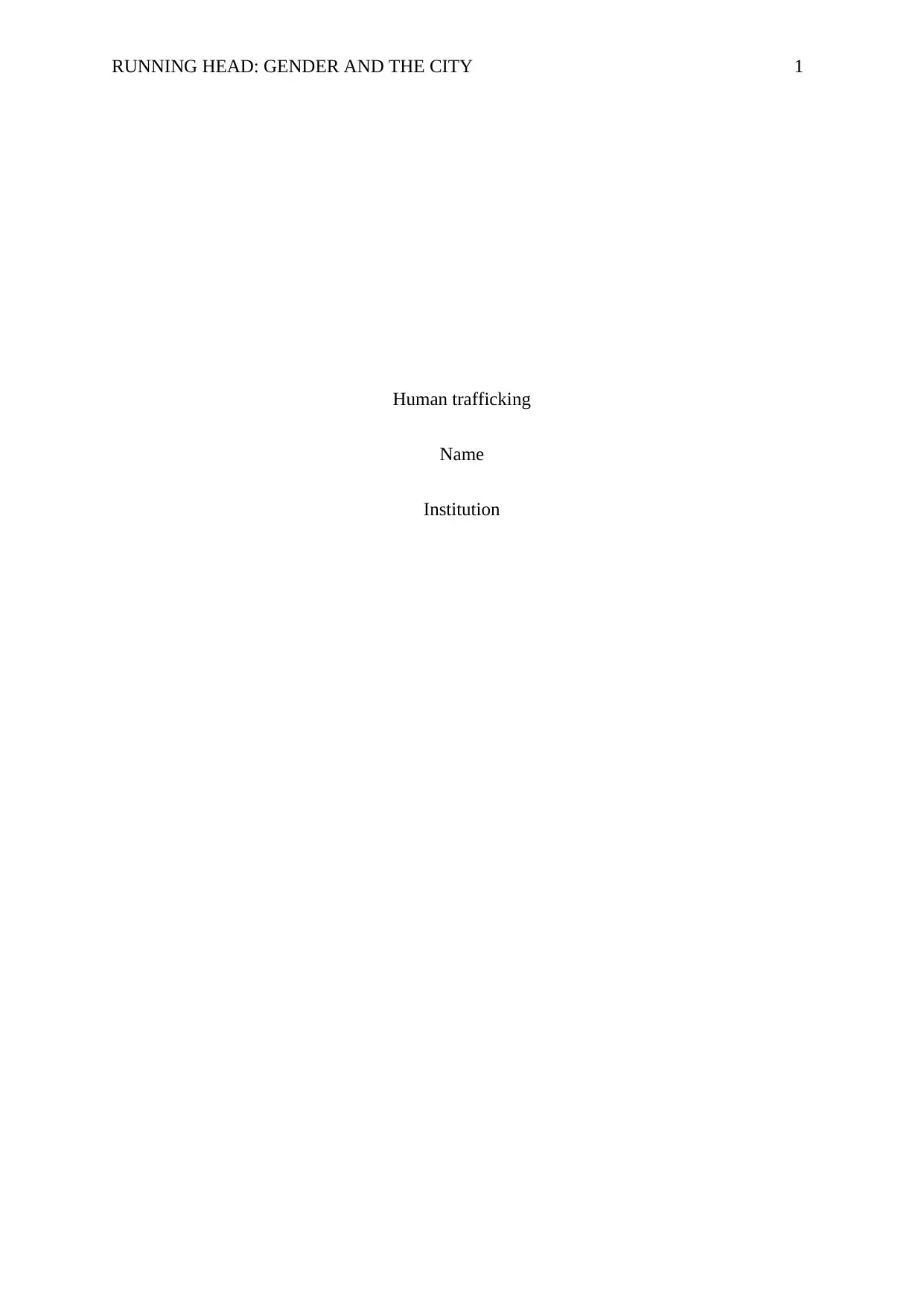
RUNNING HEAD: GENDER AND THE CITY 1
Human trafficking
Name
Institution
Human trafficking
Name
Institution
Paraphrase This Document
Need a fresh take? Get an instant paraphrase of this document with our AI Paraphraser
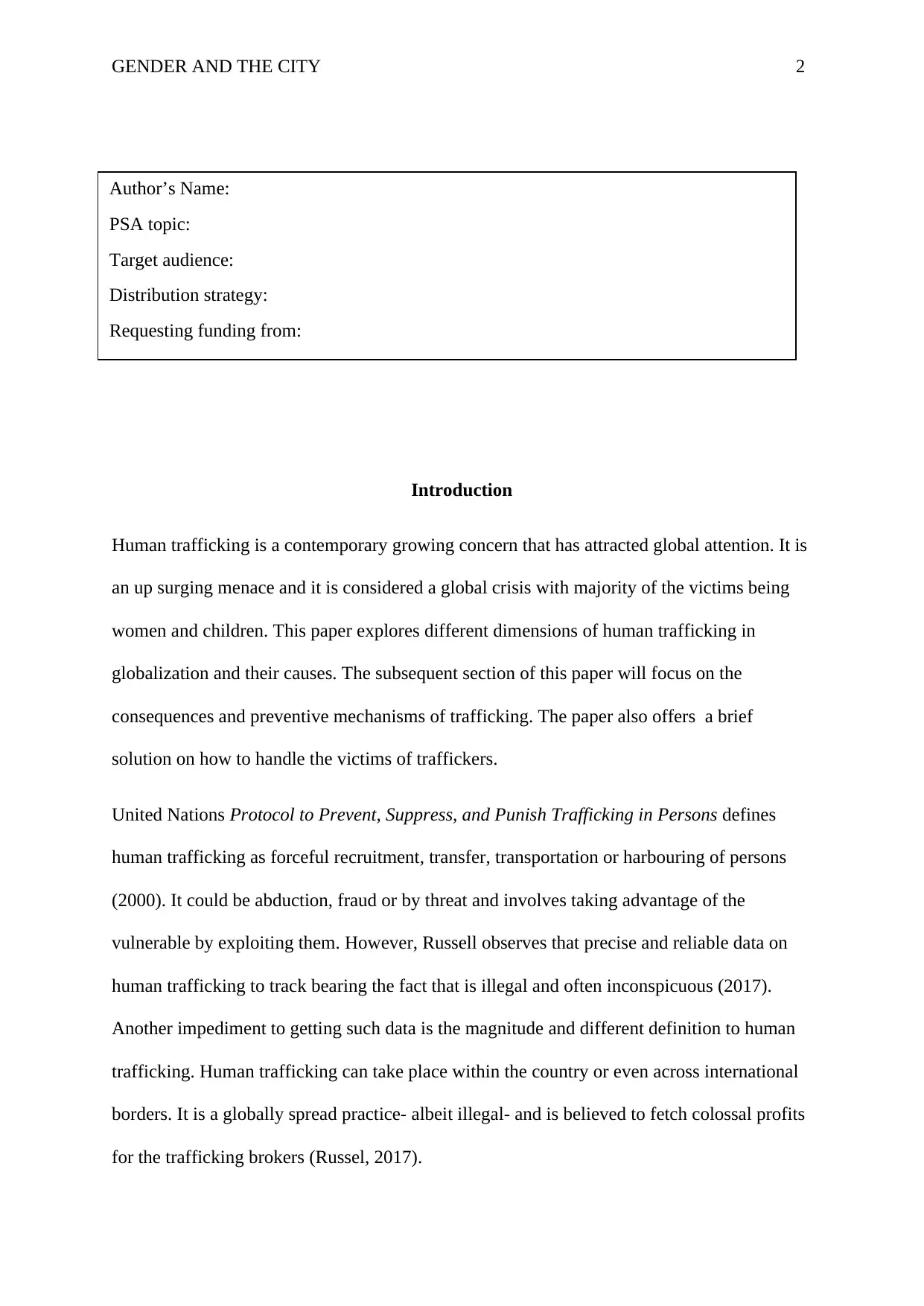
GENDER AND THE CITY 2
Introduction
Human trafficking is a contemporary growing concern that has attracted global attention. It is
an up surging menace and it is considered a global crisis with majority of the victims being
women and children. This paper explores different dimensions of human trafficking in
globalization and their causes. The subsequent section of this paper will focus on the
consequences and preventive mechanisms of trafficking. The paper also offers a brief
solution on how to handle the victims of traffickers.
United Nations Protocol to Prevent, Suppress, and Punish Trafficking in Persons defines
human trafficking as forceful recruitment, transfer, transportation or harbouring of persons
(2000). It could be abduction, fraud or by threat and involves taking advantage of the
vulnerable by exploiting them. However, Russell observes that precise and reliable data on
human trafficking to track bearing the fact that is illegal and often inconspicuous (2017).
Another impediment to getting such data is the magnitude and different definition to human
trafficking. Human trafficking can take place within the country or even across international
borders. It is a globally spread practice- albeit illegal- and is believed to fetch colossal profits
for the trafficking brokers (Russel, 2017).
Author’s Name:
PSA topic:
Target audience:
Distribution strategy:
Requesting funding from:
Introduction
Human trafficking is a contemporary growing concern that has attracted global attention. It is
an up surging menace and it is considered a global crisis with majority of the victims being
women and children. This paper explores different dimensions of human trafficking in
globalization and their causes. The subsequent section of this paper will focus on the
consequences and preventive mechanisms of trafficking. The paper also offers a brief
solution on how to handle the victims of traffickers.
United Nations Protocol to Prevent, Suppress, and Punish Trafficking in Persons defines
human trafficking as forceful recruitment, transfer, transportation or harbouring of persons
(2000). It could be abduction, fraud or by threat and involves taking advantage of the
vulnerable by exploiting them. However, Russell observes that precise and reliable data on
human trafficking to track bearing the fact that is illegal and often inconspicuous (2017).
Another impediment to getting such data is the magnitude and different definition to human
trafficking. Human trafficking can take place within the country or even across international
borders. It is a globally spread practice- albeit illegal- and is believed to fetch colossal profits
for the trafficking brokers (Russel, 2017).
Author’s Name:
PSA topic:
Target audience:
Distribution strategy:
Requesting funding from:
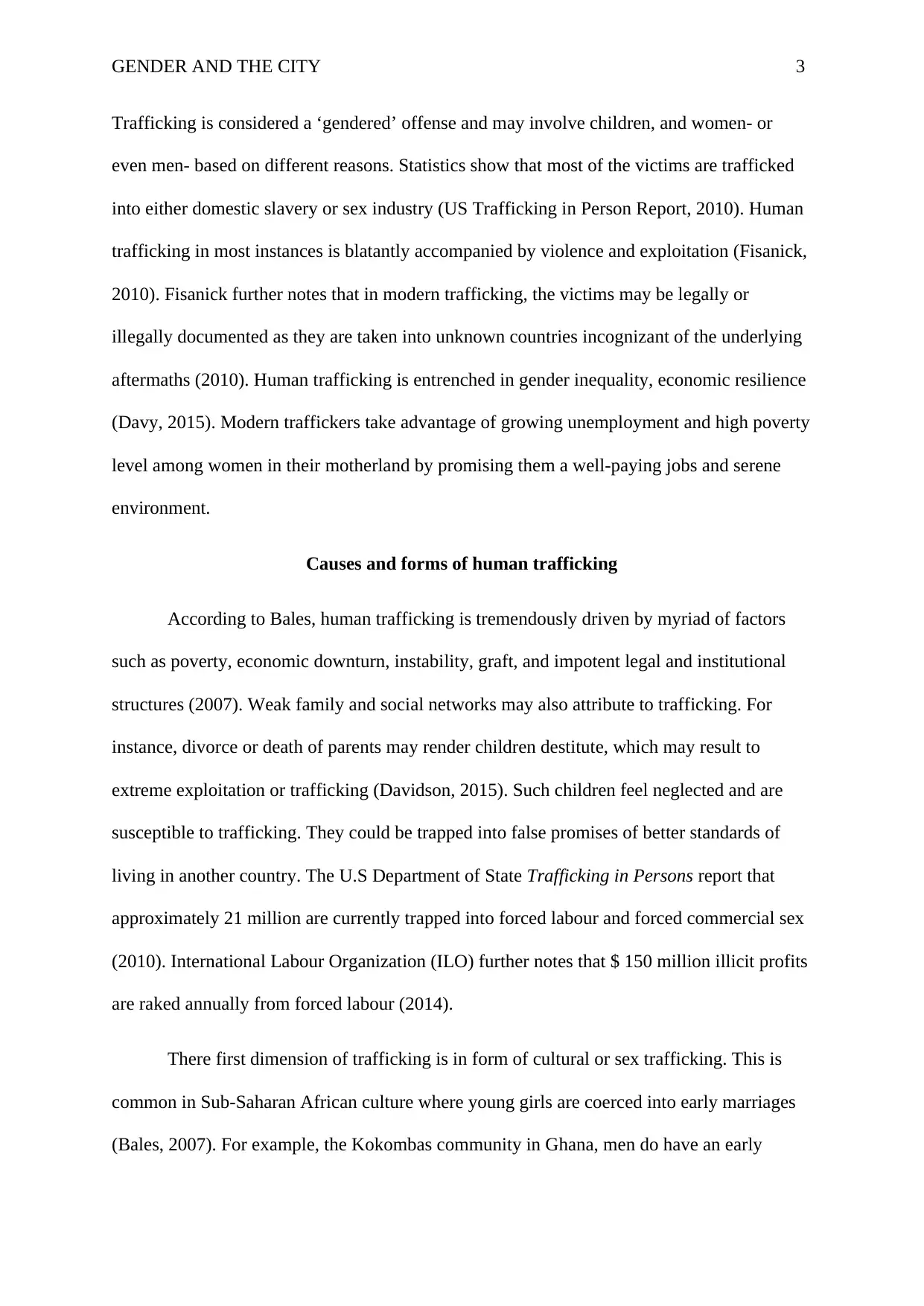
GENDER AND THE CITY 3
Trafficking is considered a ‘gendered’ offense and may involve children, and women- or
even men- based on different reasons. Statistics show that most of the victims are trafficked
into either domestic slavery or sex industry (US Trafficking in Person Report, 2010). Human
trafficking in most instances is blatantly accompanied by violence and exploitation (Fisanick,
2010). Fisanick further notes that in modern trafficking, the victims may be legally or
illegally documented as they are taken into unknown countries incognizant of the underlying
aftermaths (2010). Human trafficking is entrenched in gender inequality, economic resilience
(Davy, 2015). Modern traffickers take advantage of growing unemployment and high poverty
level among women in their motherland by promising them a well-paying jobs and serene
environment.
Causes and forms of human trafficking
According to Bales, human trafficking is tremendously driven by myriad of factors
such as poverty, economic downturn, instability, graft, and impotent legal and institutional
structures (2007). Weak family and social networks may also attribute to trafficking. For
instance, divorce or death of parents may render children destitute, which may result to
extreme exploitation or trafficking (Davidson, 2015). Such children feel neglected and are
susceptible to trafficking. They could be trapped into false promises of better standards of
living in another country. The U.S Department of State Trafficking in Persons report that
approximately 21 million are currently trapped into forced labour and forced commercial sex
(2010). International Labour Organization (ILO) further notes that $ 150 million illicit profits
are raked annually from forced labour (2014).
There first dimension of trafficking is in form of cultural or sex trafficking. This is
common in Sub-Saharan African culture where young girls are coerced into early marriages
(Bales, 2007). For example, the Kokombas community in Ghana, men do have an early
Trafficking is considered a ‘gendered’ offense and may involve children, and women- or
even men- based on different reasons. Statistics show that most of the victims are trafficked
into either domestic slavery or sex industry (US Trafficking in Person Report, 2010). Human
trafficking in most instances is blatantly accompanied by violence and exploitation (Fisanick,
2010). Fisanick further notes that in modern trafficking, the victims may be legally or
illegally documented as they are taken into unknown countries incognizant of the underlying
aftermaths (2010). Human trafficking is entrenched in gender inequality, economic resilience
(Davy, 2015). Modern traffickers take advantage of growing unemployment and high poverty
level among women in their motherland by promising them a well-paying jobs and serene
environment.
Causes and forms of human trafficking
According to Bales, human trafficking is tremendously driven by myriad of factors
such as poverty, economic downturn, instability, graft, and impotent legal and institutional
structures (2007). Weak family and social networks may also attribute to trafficking. For
instance, divorce or death of parents may render children destitute, which may result to
extreme exploitation or trafficking (Davidson, 2015). Such children feel neglected and are
susceptible to trafficking. They could be trapped into false promises of better standards of
living in another country. The U.S Department of State Trafficking in Persons report that
approximately 21 million are currently trapped into forced labour and forced commercial sex
(2010). International Labour Organization (ILO) further notes that $ 150 million illicit profits
are raked annually from forced labour (2014).
There first dimension of trafficking is in form of cultural or sex trafficking. This is
common in Sub-Saharan African culture where young girls are coerced into early marriages
(Bales, 2007). For example, the Kokombas community in Ghana, men do have an early
⊘ This is a preview!⊘
Do you want full access?
Subscribe today to unlock all pages.

Trusted by 1+ million students worldwide
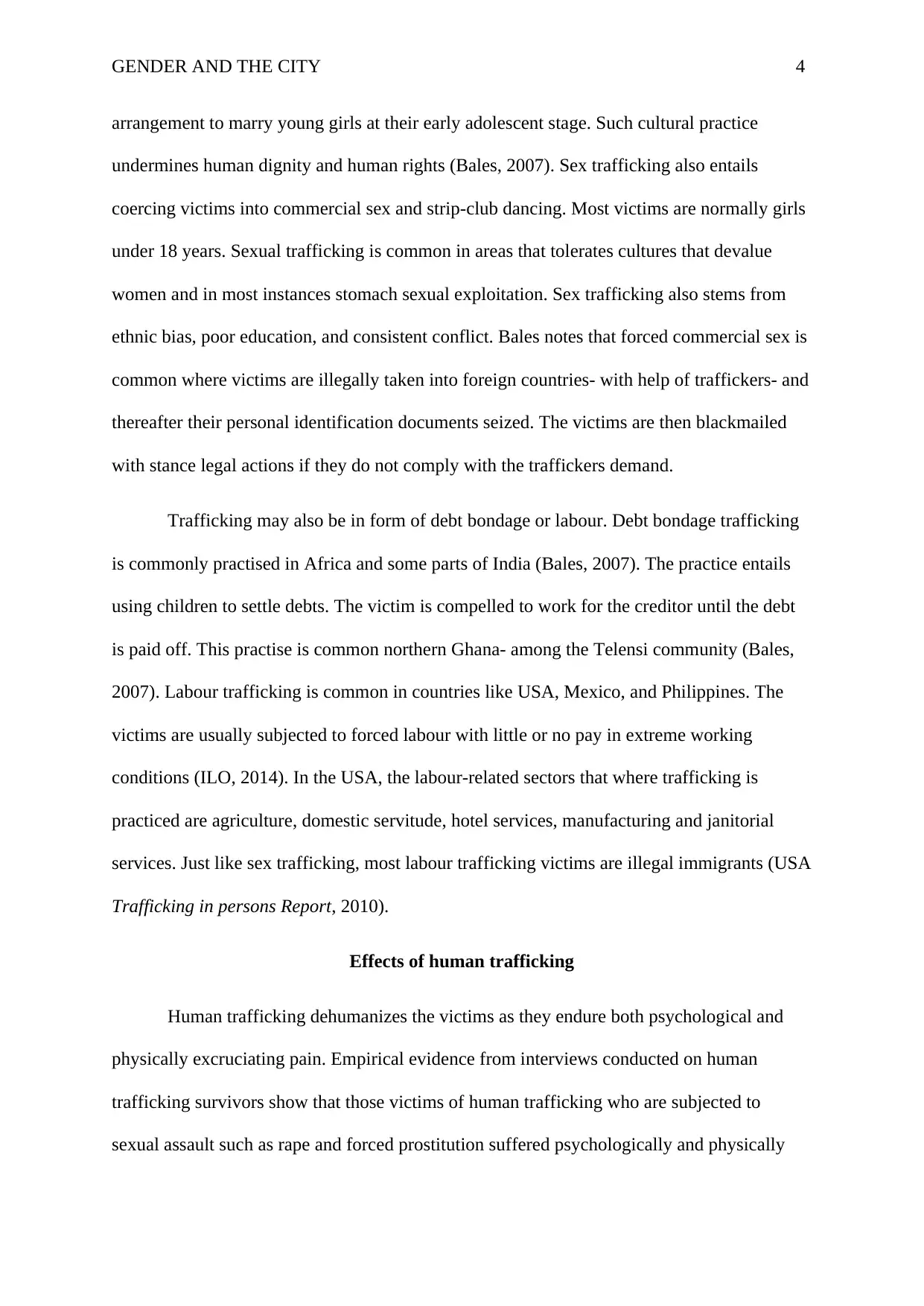
GENDER AND THE CITY 4
arrangement to marry young girls at their early adolescent stage. Such cultural practice
undermines human dignity and human rights (Bales, 2007). Sex trafficking also entails
coercing victims into commercial sex and strip-club dancing. Most victims are normally girls
under 18 years. Sexual trafficking is common in areas that tolerates cultures that devalue
women and in most instances stomach sexual exploitation. Sex trafficking also stems from
ethnic bias, poor education, and consistent conflict. Bales notes that forced commercial sex is
common where victims are illegally taken into foreign countries- with help of traffickers- and
thereafter their personal identification documents seized. The victims are then blackmailed
with stance legal actions if they do not comply with the traffickers demand.
Trafficking may also be in form of debt bondage or labour. Debt bondage trafficking
is commonly practised in Africa and some parts of India (Bales, 2007). The practice entails
using children to settle debts. The victim is compelled to work for the creditor until the debt
is paid off. This practise is common northern Ghana- among the Telensi community (Bales,
2007). Labour trafficking is common in countries like USA, Mexico, and Philippines. The
victims are usually subjected to forced labour with little or no pay in extreme working
conditions (ILO, 2014). In the USA, the labour-related sectors that where trafficking is
practiced are agriculture, domestic servitude, hotel services, manufacturing and janitorial
services. Just like sex trafficking, most labour trafficking victims are illegal immigrants (USA
Trafficking in persons Report, 2010).
Effects of human trafficking
Human trafficking dehumanizes the victims as they endure both psychological and
physically excruciating pain. Empirical evidence from interviews conducted on human
trafficking survivors show that those victims of human trafficking who are subjected to
sexual assault such as rape and forced prostitution suffered psychologically and physically
arrangement to marry young girls at their early adolescent stage. Such cultural practice
undermines human dignity and human rights (Bales, 2007). Sex trafficking also entails
coercing victims into commercial sex and strip-club dancing. Most victims are normally girls
under 18 years. Sexual trafficking is common in areas that tolerates cultures that devalue
women and in most instances stomach sexual exploitation. Sex trafficking also stems from
ethnic bias, poor education, and consistent conflict. Bales notes that forced commercial sex is
common where victims are illegally taken into foreign countries- with help of traffickers- and
thereafter their personal identification documents seized. The victims are then blackmailed
with stance legal actions if they do not comply with the traffickers demand.
Trafficking may also be in form of debt bondage or labour. Debt bondage trafficking
is commonly practised in Africa and some parts of India (Bales, 2007). The practice entails
using children to settle debts. The victim is compelled to work for the creditor until the debt
is paid off. This practise is common northern Ghana- among the Telensi community (Bales,
2007). Labour trafficking is common in countries like USA, Mexico, and Philippines. The
victims are usually subjected to forced labour with little or no pay in extreme working
conditions (ILO, 2014). In the USA, the labour-related sectors that where trafficking is
practiced are agriculture, domestic servitude, hotel services, manufacturing and janitorial
services. Just like sex trafficking, most labour trafficking victims are illegal immigrants (USA
Trafficking in persons Report, 2010).
Effects of human trafficking
Human trafficking dehumanizes the victims as they endure both psychological and
physically excruciating pain. Empirical evidence from interviews conducted on human
trafficking survivors show that those victims of human trafficking who are subjected to
sexual assault such as rape and forced prostitution suffered psychologically and physically
Paraphrase This Document
Need a fresh take? Get an instant paraphrase of this document with our AI Paraphraser
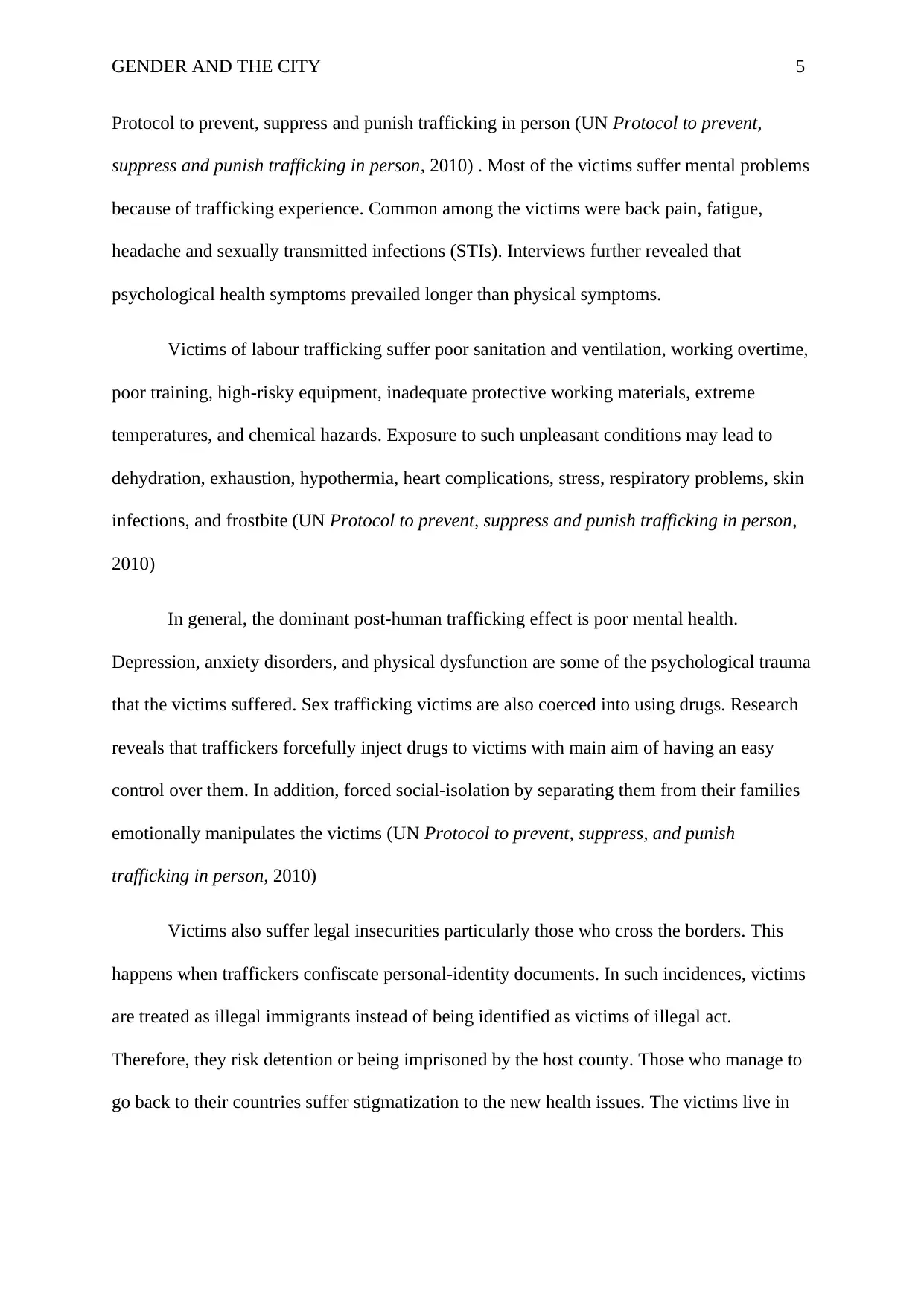
GENDER AND THE CITY 5
Protocol to prevent, suppress and punish trafficking in person (UN Protocol to prevent,
suppress and punish trafficking in person, 2010) . Most of the victims suffer mental problems
because of trafficking experience. Common among the victims were back pain, fatigue,
headache and sexually transmitted infections (STIs). Interviews further revealed that
psychological health symptoms prevailed longer than physical symptoms.
Victims of labour trafficking suffer poor sanitation and ventilation, working overtime,
poor training, high-risky equipment, inadequate protective working materials, extreme
temperatures, and chemical hazards. Exposure to such unpleasant conditions may lead to
dehydration, exhaustion, hypothermia, heart complications, stress, respiratory problems, skin
infections, and frostbite (UN Protocol to prevent, suppress and punish trafficking in person,
2010)
In general, the dominant post-human trafficking effect is poor mental health.
Depression, anxiety disorders, and physical dysfunction are some of the psychological trauma
that the victims suffered. Sex trafficking victims are also coerced into using drugs. Research
reveals that traffickers forcefully inject drugs to victims with main aim of having an easy
control over them. In addition, forced social-isolation by separating them from their families
emotionally manipulates the victims (UN Protocol to prevent, suppress, and punish
trafficking in person, 2010)
Victims also suffer legal insecurities particularly those who cross the borders. This
happens when traffickers confiscate personal-identity documents. In such incidences, victims
are treated as illegal immigrants instead of being identified as victims of illegal act.
Therefore, they risk detention or being imprisoned by the host county. Those who manage to
go back to their countries suffer stigmatization to the new health issues. The victims live in
Protocol to prevent, suppress and punish trafficking in person (UN Protocol to prevent,
suppress and punish trafficking in person, 2010) . Most of the victims suffer mental problems
because of trafficking experience. Common among the victims were back pain, fatigue,
headache and sexually transmitted infections (STIs). Interviews further revealed that
psychological health symptoms prevailed longer than physical symptoms.
Victims of labour trafficking suffer poor sanitation and ventilation, working overtime,
poor training, high-risky equipment, inadequate protective working materials, extreme
temperatures, and chemical hazards. Exposure to such unpleasant conditions may lead to
dehydration, exhaustion, hypothermia, heart complications, stress, respiratory problems, skin
infections, and frostbite (UN Protocol to prevent, suppress and punish trafficking in person,
2010)
In general, the dominant post-human trafficking effect is poor mental health.
Depression, anxiety disorders, and physical dysfunction are some of the psychological trauma
that the victims suffered. Sex trafficking victims are also coerced into using drugs. Research
reveals that traffickers forcefully inject drugs to victims with main aim of having an easy
control over them. In addition, forced social-isolation by separating them from their families
emotionally manipulates the victims (UN Protocol to prevent, suppress, and punish
trafficking in person, 2010)
Victims also suffer legal insecurities particularly those who cross the borders. This
happens when traffickers confiscate personal-identity documents. In such incidences, victims
are treated as illegal immigrants instead of being identified as victims of illegal act.
Therefore, they risk detention or being imprisoned by the host county. Those who manage to
go back to their countries suffer stigmatization to the new health issues. The victims live in
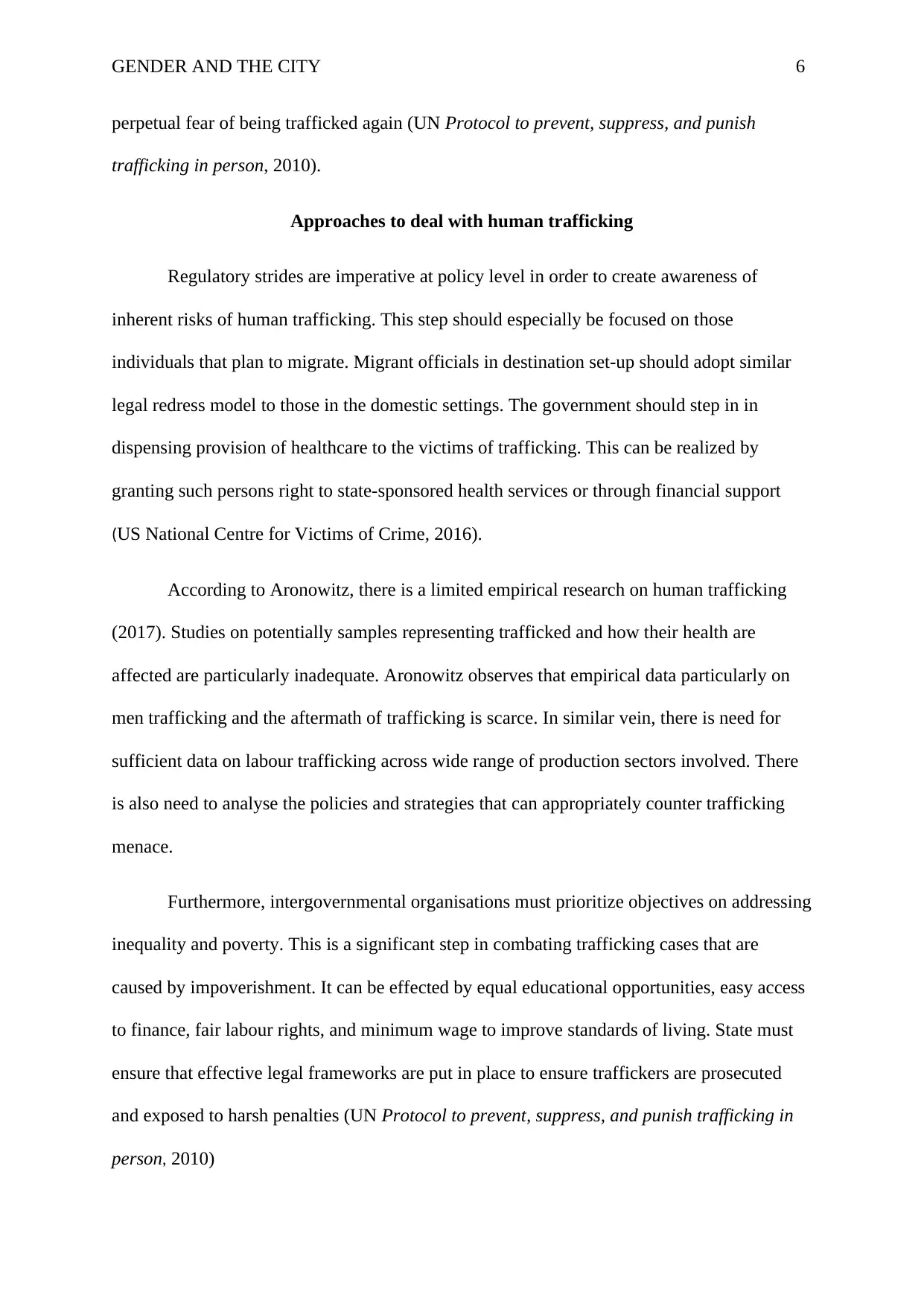
GENDER AND THE CITY 6
perpetual fear of being trafficked again (UN Protocol to prevent, suppress, and punish
trafficking in person, 2010).
Approaches to deal with human trafficking
Regulatory strides are imperative at policy level in order to create awareness of
inherent risks of human trafficking. This step should especially be focused on those
individuals that plan to migrate. Migrant officials in destination set-up should adopt similar
legal redress model to those in the domestic settings. The government should step in in
dispensing provision of healthcare to the victims of trafficking. This can be realized by
granting such persons right to state-sponsored health services or through financial support
(US National Centre for Victims of Crime, 2016).
According to Aronowitz, there is a limited empirical research on human trafficking
(2017). Studies on potentially samples representing trafficked and how their health are
affected are particularly inadequate. Aronowitz observes that empirical data particularly on
men trafficking and the aftermath of trafficking is scarce. In similar vein, there is need for
sufficient data on labour trafficking across wide range of production sectors involved. There
is also need to analyse the policies and strategies that can appropriately counter trafficking
menace.
Furthermore, intergovernmental organisations must prioritize objectives on addressing
inequality and poverty. This is a significant step in combating trafficking cases that are
caused by impoverishment. It can be effected by equal educational opportunities, easy access
to finance, fair labour rights, and minimum wage to improve standards of living. State must
ensure that effective legal frameworks are put in place to ensure traffickers are prosecuted
and exposed to harsh penalties (UN Protocol to prevent, suppress, and punish trafficking in
person, 2010)
perpetual fear of being trafficked again (UN Protocol to prevent, suppress, and punish
trafficking in person, 2010).
Approaches to deal with human trafficking
Regulatory strides are imperative at policy level in order to create awareness of
inherent risks of human trafficking. This step should especially be focused on those
individuals that plan to migrate. Migrant officials in destination set-up should adopt similar
legal redress model to those in the domestic settings. The government should step in in
dispensing provision of healthcare to the victims of trafficking. This can be realized by
granting such persons right to state-sponsored health services or through financial support
(US National Centre for Victims of Crime, 2016).
According to Aronowitz, there is a limited empirical research on human trafficking
(2017). Studies on potentially samples representing trafficked and how their health are
affected are particularly inadequate. Aronowitz observes that empirical data particularly on
men trafficking and the aftermath of trafficking is scarce. In similar vein, there is need for
sufficient data on labour trafficking across wide range of production sectors involved. There
is also need to analyse the policies and strategies that can appropriately counter trafficking
menace.
Furthermore, intergovernmental organisations must prioritize objectives on addressing
inequality and poverty. This is a significant step in combating trafficking cases that are
caused by impoverishment. It can be effected by equal educational opportunities, easy access
to finance, fair labour rights, and minimum wage to improve standards of living. State must
ensure that effective legal frameworks are put in place to ensure traffickers are prosecuted
and exposed to harsh penalties (UN Protocol to prevent, suppress, and punish trafficking in
person, 2010)
⊘ This is a preview!⊘
Do you want full access?
Subscribe today to unlock all pages.

Trusted by 1+ million students worldwide
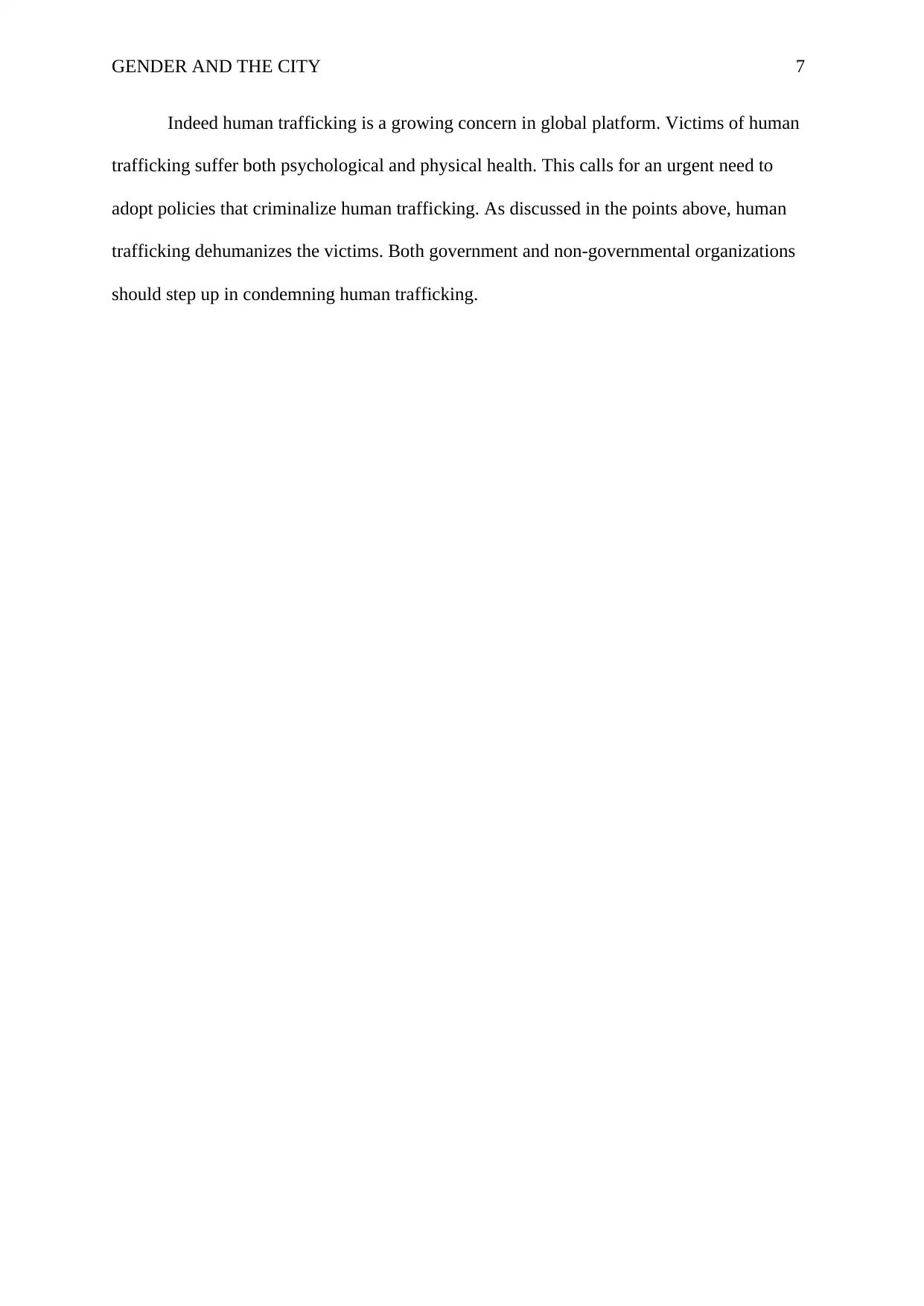
GENDER AND THE CITY 7
Indeed human trafficking is a growing concern in global platform. Victims of human
trafficking suffer both psychological and physical health. This calls for an urgent need to
adopt policies that criminalize human trafficking. As discussed in the points above, human
trafficking dehumanizes the victims. Both government and non-governmental organizations
should step up in condemning human trafficking.
Indeed human trafficking is a growing concern in global platform. Victims of human
trafficking suffer both psychological and physical health. This calls for an urgent need to
adopt policies that criminalize human trafficking. As discussed in the points above, human
trafficking dehumanizes the victims. Both government and non-governmental organizations
should step up in condemning human trafficking.
Paraphrase This Document
Need a fresh take? Get an instant paraphrase of this document with our AI Paraphraser
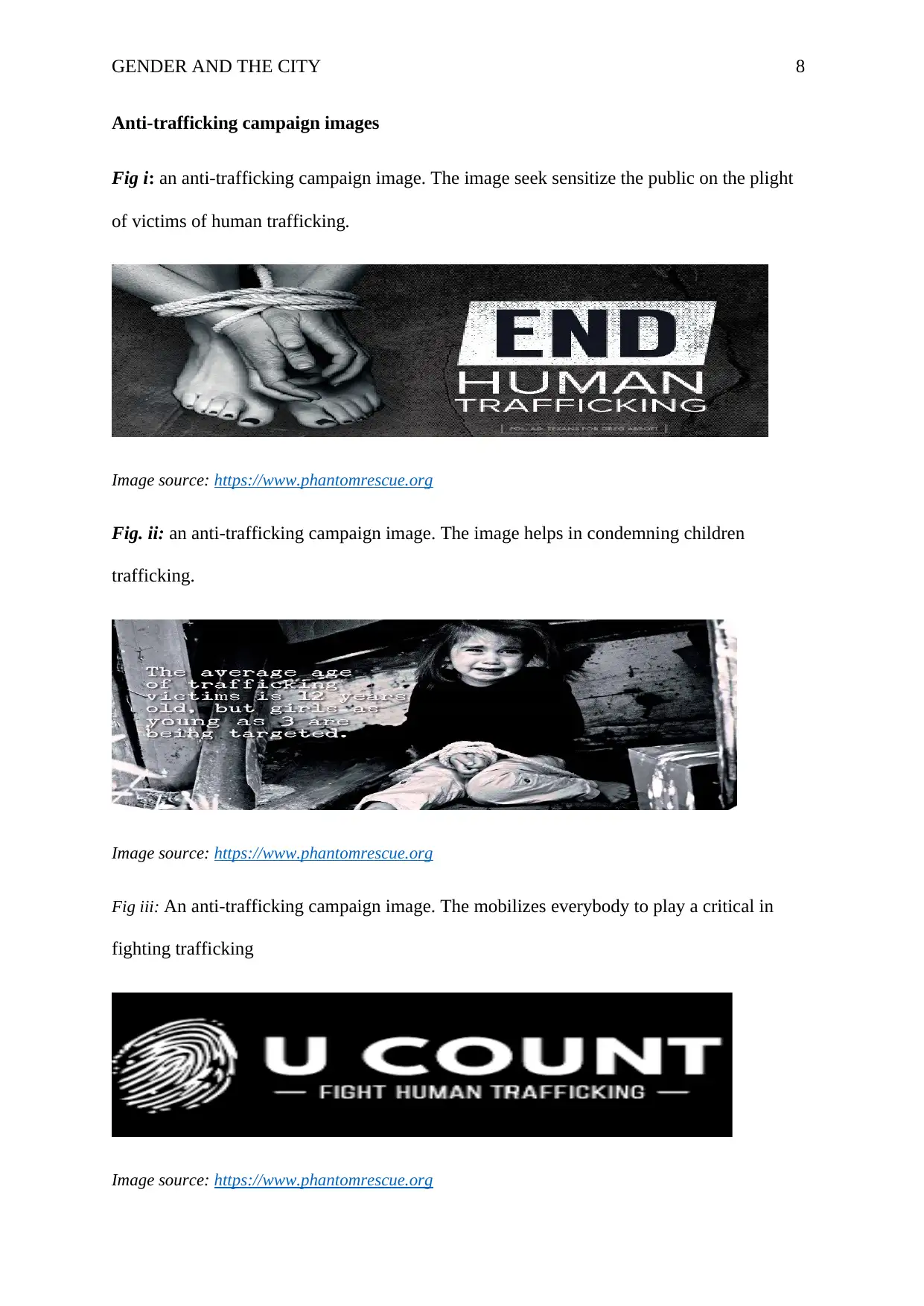
GENDER AND THE CITY 8
Anti-trafficking campaign images
Fig i: an anti-trafficking campaign image. The image seek sensitize the public on the plight
of victims of human trafficking.
Image source: https://www.phantomrescue.org
Fig. ii: an anti-trafficking campaign image. The image helps in condemning children
trafficking.
Image source: https://www.phantomrescue.org
Fig iii: An anti-trafficking campaign image. The mobilizes everybody to play a critical in
fighting trafficking
Image source: https://www.phantomrescue.org
Anti-trafficking campaign images
Fig i: an anti-trafficking campaign image. The image seek sensitize the public on the plight
of victims of human trafficking.
Image source: https://www.phantomrescue.org
Fig. ii: an anti-trafficking campaign image. The image helps in condemning children
trafficking.
Image source: https://www.phantomrescue.org
Fig iii: An anti-trafficking campaign image. The mobilizes everybody to play a critical in
fighting trafficking
Image source: https://www.phantomrescue.org
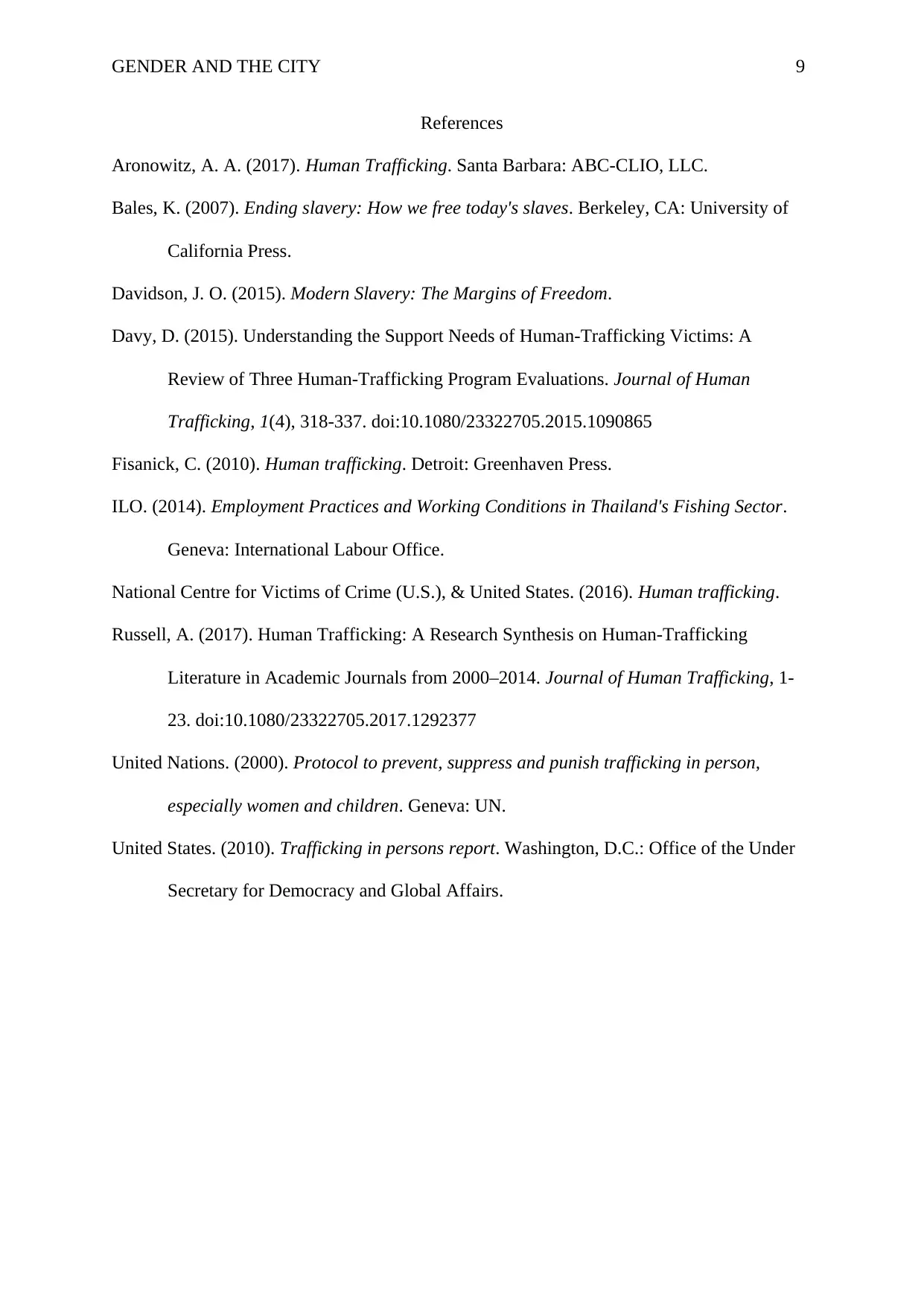
GENDER AND THE CITY 9
References
Aronowitz, A. A. (2017). Human Trafficking. Santa Barbara: ABC-CLIO, LLC.
Bales, K. (2007). Ending slavery: How we free today's slaves. Berkeley, CA: University of
California Press.
Davidson, J. O. (2015). Modern Slavery: The Margins of Freedom.
Davy, D. (2015). Understanding the Support Needs of Human-Trafficking Victims: A
Review of Three Human-Trafficking Program Evaluations. Journal of Human
Trafficking, 1(4), 318-337. doi:10.1080/23322705.2015.1090865
Fisanick, C. (2010). Human trafficking. Detroit: Greenhaven Press.
ILO. (2014). Employment Practices and Working Conditions in Thailand's Fishing Sector.
Geneva: International Labour Office.
National Centre for Victims of Crime (U.S.), & United States. (2016). Human trafficking.
Russell, A. (2017). Human Trafficking: A Research Synthesis on Human-Trafficking
Literature in Academic Journals from 2000–2014. Journal of Human Trafficking, 1-
23. doi:10.1080/23322705.2017.1292377
United Nations. (2000). Protocol to prevent, suppress and punish trafficking in person,
especially women and children. Geneva: UN.
United States. (2010). Trafficking in persons report. Washington, D.C.: Office of the Under
Secretary for Democracy and Global Affairs.
References
Aronowitz, A. A. (2017). Human Trafficking. Santa Barbara: ABC-CLIO, LLC.
Bales, K. (2007). Ending slavery: How we free today's slaves. Berkeley, CA: University of
California Press.
Davidson, J. O. (2015). Modern Slavery: The Margins of Freedom.
Davy, D. (2015). Understanding the Support Needs of Human-Trafficking Victims: A
Review of Three Human-Trafficking Program Evaluations. Journal of Human
Trafficking, 1(4), 318-337. doi:10.1080/23322705.2015.1090865
Fisanick, C. (2010). Human trafficking. Detroit: Greenhaven Press.
ILO. (2014). Employment Practices and Working Conditions in Thailand's Fishing Sector.
Geneva: International Labour Office.
National Centre for Victims of Crime (U.S.), & United States. (2016). Human trafficking.
Russell, A. (2017). Human Trafficking: A Research Synthesis on Human-Trafficking
Literature in Academic Journals from 2000–2014. Journal of Human Trafficking, 1-
23. doi:10.1080/23322705.2017.1292377
United Nations. (2000). Protocol to prevent, suppress and punish trafficking in person,
especially women and children. Geneva: UN.
United States. (2010). Trafficking in persons report. Washington, D.C.: Office of the Under
Secretary for Democracy and Global Affairs.
⊘ This is a preview!⊘
Do you want full access?
Subscribe today to unlock all pages.

Trusted by 1+ million students worldwide
1 out of 9
Related Documents
Your All-in-One AI-Powered Toolkit for Academic Success.
+13062052269
info@desklib.com
Available 24*7 on WhatsApp / Email
![[object Object]](/_next/static/media/star-bottom.7253800d.svg)
Unlock your academic potential
Copyright © 2020–2025 A2Z Services. All Rights Reserved. Developed and managed by ZUCOL.





